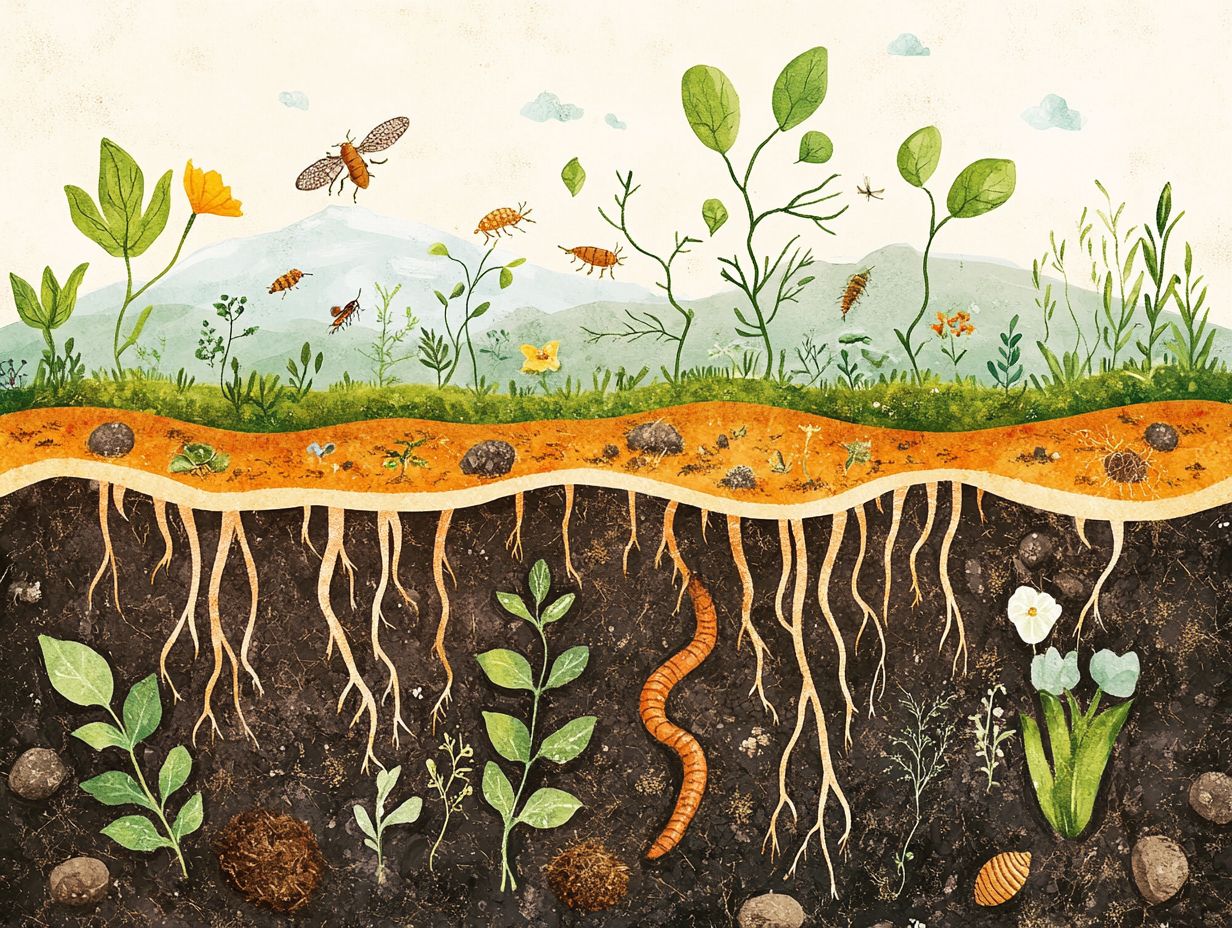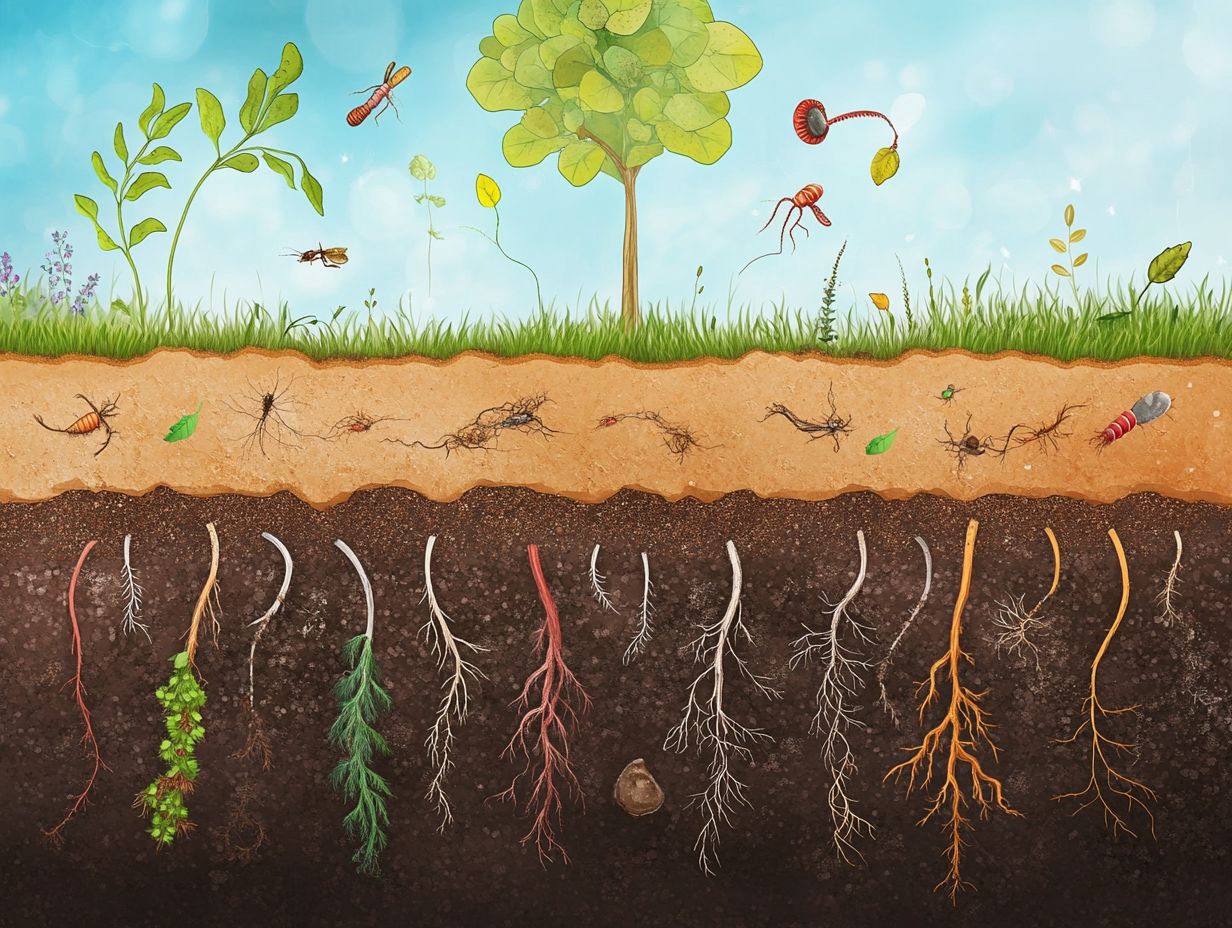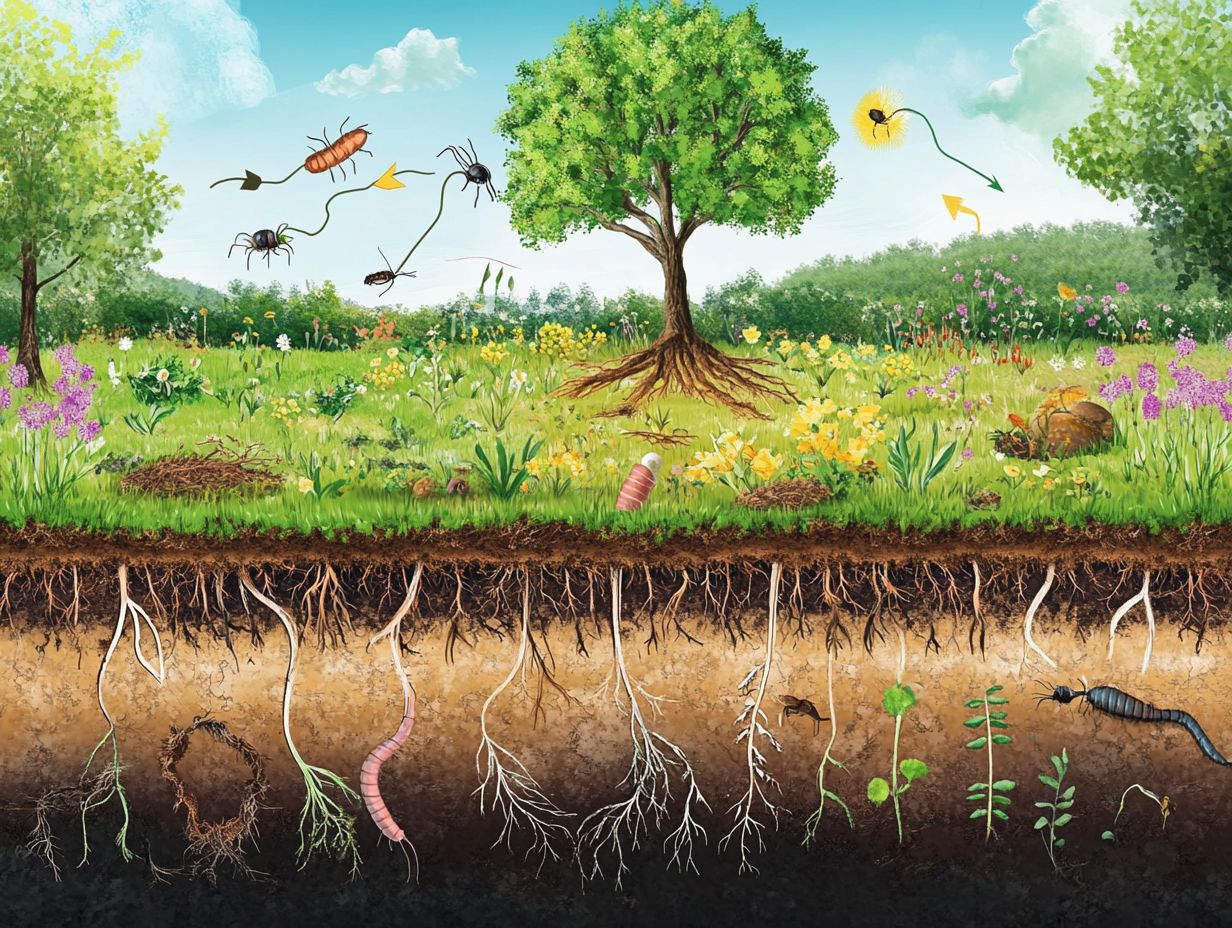Understanding the Soil Nutrient Cycle
Soil transcends being merely dirt; it serves as a dynamic ecosystem essential for the growth and vitality of plants.
The soil nutrient cycle sustains this ecosystem. It includes vital nutrients like nitrogen, phosphorus, and potassium, all influenced by climate and human actions.
Dive into the stages of nutrient cycling! Discover exciting strategies for sustainable soil management that will transform your gardening adventures. Understanding the importance of nurturing the soil can lead to abundant harvests and contribute to a healthier planet.
Contents
- Key Takeaways:
- Unlocking the Secrets of the Soil Nutrient Cycle!
- Key Nutrients Involved in the Cycle
- The Process of Nutrient Cycling
- Factors Affecting the Soil Nutrient Cycle
- Impact of the Soil Nutrient Cycle on Plant Growth
- Ways to Improve and Maintain the Soil Nutrient Cycle
- Frequently Asked Questions
- What is the soil nutrient cycle?
- What exactly happens in the soil nutrient cycle?
- Why is understanding the soil nutrient cycle important?
- What are the main nutrients involved in the soil nutrient cycle?
- How does human activity impact the soil nutrient cycle?
- Can the soil nutrient cycle be improved or enhanced?
Key Takeaways:

- The soil nutrient cycle is nature s way of recycling vital nutrients for healthy plant growth.
- Nitrogen, phosphorus, and potassium are the three key nutrients involved in the cycle, crucial for optimal plant growth.
- To maintain a healthy soil nutrient cycle, consider factors like climate, soil type, and human activities while implementing sustainable practices.
Unlocking the Secrets of the Soil Nutrient Cycle!
The soil nutrient cycle is a complex process that illustrates the transformation and exchange of essential nutrients like nitrogen, phosphorus, and potassium within the soil ecosystem. This cycle plays a pivotal role in determining soil fertility and plant health.
It encompasses various components, including soil organisms, organic matter, and microbial biomass, all collaborating to sustain nutrient flows and bolster agricultural practices. Understanding the nuances of this cycle is vital to enhance soil fertility, optimize crop production, and mitigate environmental impacts associated with nutrient depletion.
Definition and Importance
The soil nutrient cycle refers to continuous processes that recycle essential nutrients, ensuring your plants receive everything they need for optimal growth and health.
This dynamic cycle is vital for maintaining soil fertility and supports entire ecosystems. As organic matter decomposes, nutrient-rich compounds are released back into the soil, creating a fertile environment where various organisms can flourish.
Microbial activity is particularly noteworthy; these tiny yet mighty organisms break down complex organic materials, transforming them into simpler forms that plants can easily absorb. By facilitating interactions between roots and microorganisms, the nutrient cycle enhances plant resilience against pests and environmental stresses.
This highlights its essential role in sustaining both agricultural productivity and natural habitats, making it a cornerstone of successful gardening or farming endeavors.
Key Nutrients Involved in the Cycle
Key nutrients in the soil nutrient cycle namely nitrogen, phosphorus, and potassium are essential for promoting robust plant growth and development. Each of these elements contributes uniquely to the health and vitality of your plants, ensuring they thrive in their environment.
Understanding their roles can significantly enhance your gardening or agricultural practices.
Nitrogen, Phosphorus, and Potassium
Nitrogen, phosphorus, and potassium are the primary key nutrients that are vital for your plants’ health and play a crucial role in the soil nutrient cycle.
These nutrients have unique yet interconnected functions that significantly enhance soil fertility and plant vitality. Nitrogen boosts your plants’ growth by promoting lush leaf development and maximizing chlorophyll production. Phosphorus is essential for energy transfer and establishing strong roots, especially during early growth stages. Potassium helps regulate water and activates enzymes, ensuring your plants remain resilient through various challenges.
Together, these nutrients undergo a series of transformation processes, such as mineralization and immobilization, to keep a balanced nutrient supply flowing. Their dynamic interactions within the soil ecosystem directly influence nutrient availability, ultimately impacting your plants’ productivity and the long-term health of your soil.
The Process of Nutrient Cycling

The process of nutrient cycling encompasses multiple stages, beginning with the decomposition of organic matter. This vital step releases nutrients back into the soil, making them available for plants and other organisms to utilize effectively.
Stages and Interactions
The stages of nutrient cycling mineralization, immobilization, and leaching each play a vital role in interacting with soil organisms and organic matter to enhance nutrient availability.
During mineralization, microorganisms break down organic matter. This releases essential nutrients like nitrogen and phosphorus back into the soil, making them available for plant uptake.
Next is immobilization, where soil bacteria absorb these nutrients into their biomass, temporarily reducing their availability for plants. This dynamic interplay highlights the crucial role of soil organisms in regulating nutrient flows.
Leaching is equally important, as excess nutrients can be washed away, affecting water quality. Grasping these stages is essential for managing soil health and ensuring sustainable agricultural practices.
Factors Affecting the Soil Nutrient Cycle
Several factors influence the soil nutrient cycle, such as climate, soil type, and human activities. Each of these elements plays a crucial role in determining nutrient availability and the transformation processes occurring within the soil.
Climate, Soil Type, and Human Activities
Climate, soil type, and human activities are pivotal factors that shape the efficiency and effectiveness of nutrient cycling within the soil ecosystem. These elements engage in intricate interactions, influencing the availability of essential nutrients for both plants and microorganisms.
For example, the diversity in soil types, from sandy to clay-rich, significantly affects water retention and drainage, which in turn impacts nutrient leaching. Climate conditions, including temperature and rainfall patterns, dictate the rate at which organic matter decomposes, ultimately influencing how nutrients are replenished.
Agricultural practices, including crop rotation and fertilizer application, play a substantial role in determining soil fertility and the nutrient flow throughout ecosystems. This impacts both agricultural productivity and natural habitats.
Impact of the Soil Nutrient Cycle on Plant Growth
Your garden s success hinges on the soil nutrient cycle! This process dramatically affects the availability of essential nutrients. It not only influences soil fertility but also shapes the overall health of the ecosystem surrounding your plants.
By understanding this intricate process, you can enhance plant growth and cultivate a thriving environment.
Role in Plant Nutrition and Health

The role of the soil nutrient cycle in plant nutrition is absolutely vital. It ensures that essential nutrients are available in forms that plants can easily uptake for growth and development.
This continuous process involves the transformation and movement of nutrients through the soil, making them accessible for absorption. The availability of key nutrients like nitrogen, phosphorus, and potassium significantly influences your plants’ overall health and productivity.
Soil organic matter is crucial for maintaining soil fertility, as it improves nutrient retention and enhances microbial activity. As this organic matter decomposes, it releases nutrients in forms that are readily available to plants, fostering a balanced ecosystem that supports vigorous growth and development.
In essence, a well-functioning nutrient cycle not only nourishes your plants but also promotes sustainable agricultural practices.
Ways to Improve and Maintain the Soil Nutrient Cycle
Improving and maintaining the soil nutrient cycle is paramount for sustainable agriculture. By focusing on this vital process, you’re not just enhancing soil fertility; you’re also securing long-term productivity for your farming endeavors.
Start implementing these practices today for a thriving garden tomorrow!
Practical Tips for Sustainable Soil Management
Practical tips for sustainable soil management include incorporating organic materials, practicing crop rotation, and minimizing soil disturbance to enhance the process of nutrients moving through the soil. These strategies not only elevate soil structure and fertility but also nurture a vibrant ecosystem of microorganisms that play a vital role in overall soil health.
By integrating compost and mulches into your soil, you can significantly boost organic matter levels, leading to improved water retention and nutrient availability. Rotating crops is another powerful technique; it breaks pest and disease cycles, allowing your soils to recuperate nutrients naturally. Reducing tillage is essential as well; it minimizes disruption to the soil profile, safeguarding beneficial soil organisms and preventing erosion.
When you implement these strategies, you ll not only cultivate healthier crops but also enhance yield while fostering a sustainable agricultural system that promotes carbon sequestration and supports a balanced ecosystem.
Frequently Asked Questions
What is the soil nutrient cycle?
The soil nutrient cycle is the process by which nutrients are taken up by plants, returned to the soil through decomposition processes, and then made available for uptake by future plants. It is a continuous cycle that supports the growth and health of plants and the overall ecosystem.
What exactly happens in the soil nutrient cycle?

The soil nutrient cycle begins when plants take up nutrients from the soil through their roots. These nutrients are then used by the plants for growth and development. When the plants die or shed their leaves, the nutrients are returned to the soil through decomposition by microorganisms. The nutrients are then once again available for uptake by plants.
Why is understanding the soil nutrient cycle important?
Understanding the soil nutrient cycle is crucial because it helps us maintain healthy and productive soils. By understanding how nutrients transformations occur through the soil, we can make informed decisions about fertilization and management practices to ensure the sustainability of our agriculture and natural systems.
What are the main nutrients involved in the soil nutrient cycle?
The main nutrients involved in the soil nutrient cycle are nitrogen, phosphorus, and potassium. These are often referred to as the primary nutrients and are essential for plant growth and development. Additionally, soil pH plays a critical role in nutrient availability, while secondary nutrients such as calcium, magnesium, and sulfur, and micronutrients like iron, zinc, and copper are also important for the soil nutrient cycle.
How does human activity impact the soil nutrient cycle?
Human activities such as deforestation, agriculture, and excessive use of fertilizers can disrupt the soil nutrient cycle. These activities can lead to nutrient imbalances, soil degradation, and loss of biodiversity. Practices that increase sediment deposition can further complicate soil health. Let s take action now to manage our land sustainably!
Can the soil nutrient cycle be improved or enhanced?
Yes, the soil nutrient cycle can be improved or enhanced through various management practices such as crop rotation, cover cropping, and reducing the use of chemical fertilizers. Using organic fertilizers and compost can add essential nutrients and improve soil health. These practices help maintain a healthy and diverse community of tiny living things in the soil, including beneficial bacteria and fungi, which play a crucial role in nutrient cycling and carbon storage.






